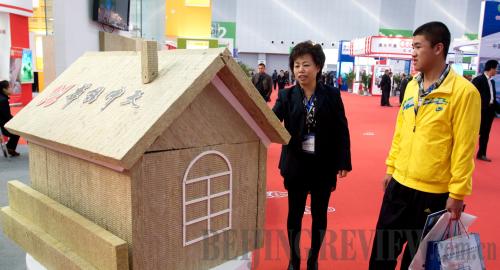|
 |
|
BEST THERMAL EFFICIENCY: Visitors examine a new type of stone wool insulation at an exhibition on construction materials in Tianjin on November 9, 2012 (WANG QINGYAN) |
"China's green buildings are at a phase of fast development and it is the right time to promote green buildings across the country," said Wang Qingqin, Deputy Secretary General of the China Green Building Council and Assistant President of the China Academy of Building Research. He said that most technologies used in green buildings are mature, which will be perfected over the time and are ready for large-scale development of green buildings. "A system of detailed standards and regulations on green buildings is taking shape," Wang said.
Wang said that the Central Government has always attached great importance to the development of green buildings and issued many documents on promoting green buildings. In May 2012, the Ministry of Finance and the Ministry of Housing and Urban-Rural Development jointly issued a list of subsidy standards for green building development in May 2012. Certified two-star and three-star buildings will enjoy government subsidies of 45 yuan ($7) per square meter and 80 yuan ($13) per square meter respectively.
Green building certification agencies have been established in many provinces, autonomous regions and municipalities. Provinces such as Jiangsu and Anhui, as well as cities such as Wuhan in Hubei Province, Qingdao in Shandong Province, Shenzhen and Guangzhou in Guangdong Province and Xi'an in Shaanxi Province, have promulgated local policies to provide subsidies and other preferential treatment for the developers and purchasers of green buildings.
Meanwhile, standards and regulations on green buildings keep coming out, which regulate these buildings' appraisal and design specifications. "The standards on green residential, industrial, educational, medical and retail properties either have been released or are being drafted," said Wang.
China has also developed its own green building rating system, which is different from the Leadership in Energy and Environmental Design certification used in the United States and Building Research Establishment Environmental Assessment Method used in Britain.
Wang attributed the difference to disparities in culture and products between the countries. "But these systems are similar in their core values, such as conservation of energy, land, water and construction materials as well as environmental friendliness. Generally speaking, China's green building rating system fits its own conditions," Wang said.
New trends
Joe Van Belleghem is director of sustainable solutions at Lend Lease, a multinational property and infrastructure company based in Sydney, Australia. He said in Beijing recently that the focus of the global green construction market is shifting from the design of green buildings to the design of green communities, healthy complexes and new office areas.
According to Belleghem, there are two trends in the development of green buildings. The first is the stress on buildings' overall effect on environment and sustainable designs. Instead of emphasizing materials employed in buildings, designers try to improve the overall protection of the environment while helping occupants to raise their quality of life, especially through bringing people living and working in city centers closer to nature.
The second trend, Belleghem said, is the newly gained emphasis on the greater context of improving quality of life for mankind besides conservation concepts.
Lend Lease entered the Chinese market 20 years ago. It recently signed a letter of intent with the China Energy Conservation and Environmental Protection Group, China's leading company in energy conservation and environmental protection solutions. According to the document, the two companies will cooperate on developing green building complexes and low-carbon communities.
Compared with constructing new green buildings, many experts suggest that upgrading existing properties would be more effective in reducing China's energy consumption at present.
"Energy efficiency of existing architectures will be increased if their energy, water supply and garbage systems can be integrated," said Nie Yaozhong, Lend Lease's head of Development in China. He believes that casual decisions to abolish old buildings and build new ones on the same site are not viable for sustainable or low-carbon development.
At the Ninth International Conference on Green and Energy-efficient Building and New Technologies and Products Expo held in Beijing in April, Lend Lease hosted a forum on building carbon neutral cities in China.
At this forum, experts agreed that while carbon neutral cities represent the best model of sustainable urban development, green buildings lead the trend for modern architectural development.
Email us at: tangyuankai@bjreview.com | 